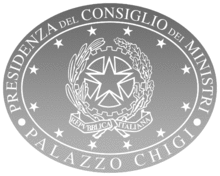Council of Ministers (Italy)

 |
| This article is part of a series on the politics and government of Italy |
| Constitution |
|
Legislature |
|
|
| Foreign relations |
|
Related topics |
The Council of Ministers (Italian: Consiglio dei Ministri, CdM) is the principal executive organ of the Government of Italy. It comprises the President of the Council (i.e. the prime minister), all the ministers, and the undersecretary to the President of the Council. Junior ministers (Italian: sottosegretari) are part of the government, but are not members of the Council of Ministers.
History
The Council of Ministers' origins date to the production of the Albertine Statute by the Kingdom of Sardinia in 1848. The Statute, which subsequently became the Constitution of the Kingdom of Italy, did not envision collegial meetings of individual ministers, but simply the existence of ministers as heads of their ministries, responsible for their operations. The Council of Ministers subsequently developed as a constitutional convention and the office of the President of the Council emerged from the need to co-ordinate the activities of the individual ministers.
Currently the Council of Ministers is governed by the Constitution[1] and Law no.400 of 23 August 1988.[2]
Organisation
The Council of Ministers consists of:
- The Prime Minister, the chair of the council, who is appointed by the President of Italy after consultations and is confirmed by a vote of both houses of Parliament;
- The Ministers, appointed by the President of Italy, according to the request of the Prime Minister.
All powers of the Council of Ministers rest in the hands of the President of Italy until the ministers assume their offices.
The Presidents of the Regions with Special Statute have the right to participate in sessions of the Council of Ministers in matters relevant to them are discussed (distinct from general issues common to all the regions). The Presidents of Sardinia, Friuli-Venezia Giulia, Aosta Valley, and Trentino-Alto Adige/Südtirol have only a consultative vote, while the President of Sicily has a full vote and the rank of a minister.[3]
Before assuming power, the Prime Minister and the Ministers must take an oath of office according to the formula laid out in Article 1.3 of Law no. 400/1988. The oath expresses the necessity of trust which is incumbent on all citizens but especially on those holding public office (derived from Article 54 of the Constitution).
Relationship with other parts of the political system
The Council of Ministers is the principal holder of executive power in the Italian system - that is, the power to put a decision of the Italian political process into effect (i.e. execute it).
- In relation to the Parliament, the "relationship of trust" (rapporto di fiducia) is crucial. For the Council of Ministers and the Prime Minister to continue in office, they must retain the political support of both chambers of Parliament. The relationship of trust is the core of the Italian parliamentary system, because it means that the Government is "responsible" to Parliament.
- The President of the Republic has the power to appoint the Prime Minister and the ministers.
- The regular judiciary is organised from an administrative point of view by the Minister of Justice. However, the independence of the judiciary in relation to the other parts of the state remains firm, as is made clear by the existence of the High Council of the Judiciary which appoints, transfers, promotes, and disciplines members of the judiciary independently of the executive branch.
The members of the Council of Ministers, even if they leave their positions, are subject to the jurisdiction of the courts for activities committed in their official capacity only with the authorisation of one of the chambers of the Parliament.[4]
Functions
As the main organ of the executive power, the Council of Ministers' primary role is the actualisation of national political decisions. The Constitution provides it with the following means of doing this:
Legislative initiative: The Council of the Ministers can present bills to the two chambers of Parliament.
Decree power: The Council of Ministers can adopt two different types of decree with legal force (that is with a legal power equivalent to laws passed by Parliament): the Decree law in cases of urgency and the Legislative decree in cases where Parliament has expressly delegated legislative authority to the Council. Frequent use of the decree power has seen substantial legislative power shift from Parliament to the Council.
Regulatory power: The ministers have two distinct but co-existing roles. They are politically the supreme executive authorities appointed by Parliament, but they are also the administrative heads of the State, whose activities they direct in accordance with the political process. As administrators, the Council and the individual ministers can produce "regulations" (regolamenti), which are legal implements subordinate to legislation.[5] Thus, regulations which contradict legislation (i.e. laws passed by parliament, decree laws, legislative decrees) are illegitimate and can be set aside by ordinary judges and annulled by administrative judges.
List of Italian Ministers
The current Italian government is led by Paolo Gentiloni. As of December 2016, the government has 16 Ministers, of whom three are without portfolio.[6]
| Party key | Democratic Party | |
|---|---|---|
| Popular Alternative | ||
| Centrists for Italy | ||
| Independent |
References
- ↑ Article 92 and following
- ↑ "Governing the Activities and the Organisation of the Presidency of the Council of Ministers"
- ↑ Decree Law no. 35, 21 January 2004.
- ↑ Article 96, Constitution
- ↑ Law no.400/1988
- ↑ "I Ministri, i Vice Ministri e i Sottosegretari del Governo Renzi". The official website of the Government of Italy.